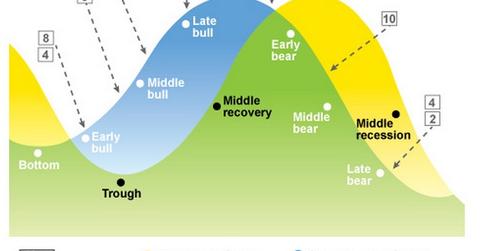ETFs That Outperform in Late Stage, Recession, and Trough
Certain industries typically outperform at various phases of business cycles. This provides important clues to investors and helps them manage their portfolios.
April 22 2015, Published 1:58 p.m. ET

Sector ETF performance fluctuates with business cycles
Every industrial economy experiences upswings and downswings in economic activity, depending on the stage of business cycle it’s in. In the expansion stage, most industries boom, and the unemployment rate goes down. Conversely, in times of contraction, economic activity declines as industries start operating below capacity. Then unemployment rises. Knowledge of expansions and contractions that determine the level of economic activity, growth, and welfare in an economy is key to investors.
Stock markets are a leading indicator of the economy
According to the efficient market hypothesis, stock markets are a leading indicator of the economy since they’re based on investor expectations. Thus, it’s important to track global equity indices that track the United States (SPY), Europe (FEZ), China (ASHR), India (EPI), and Russia (RSX), among others. This will help identify business cycles and stages from the stock market performance of broad-market and industry-specific indices.
From a historical trend analysis, we can identify that certain industries typically outperform at various phases of business cycles. This provides important clues to investors and helps them efficiently manage their portfolio performances. Here are a few of these identifiable trends.
- Consumer cyclical stocks (XLY) also perform well during the late bearing phase when the market is falling into a recession. After the trough, consumer non-cyclical stocks such as Philip Morris (PM) and Kraft Foods (KRFT) pick up pace in the face of an early bull market.
- Early in a recession, consumer staples like food and healthcare (XLV) do relatively well, because everything else that is more economically sensitive does much worse. So these stocks outperform near the economic peak in the face of an early bear market.
- Utilities do well during the middle recessionary phase of the economy when stock markets are going through a middle bear market.
- Interest rate–sensitive industries such as financials do best at the trough, as interest rates are at their bottom and stock markets show signs of an early bull run. These stocks gain from the late bear to the early bull phase in the stock market. US investors can gain exposure to the sector by investing in the Financial Select Sector SPDR ETF (XLF), which tracks financial companies and banks such as Wells Fargo (WFC), J.P. Morgan (JPM), and Bank of America (BAC).
- Stocks of industries such as energy (XLE), basic materials (XLB), and precious metals (SLV) (GLD) benefit from inflation and do best when the economy is peaking and stock markets show signs of a late bull run.
Certain sectors perform well toward the middle of an economic recovery and in the middle of a bull market. This seems to be the case currently. Let’s take a look in the next part of this series.
